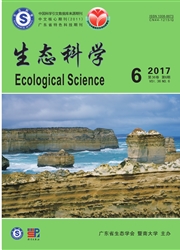

 中文摘要:
中文摘要:
为了解在亚热带地区人工栽培条件下皇竹草(Pennisetum hyardum)生物量构件随生长时间的变化,于广州地区无人工施肥和灌溉且肥力偏差的典型赤红壤土旱地上,分别对种植后4、6、12、18和24个月的皇竹草地典型样方进行了生物量构件调查分析。皇竹草在分株生长过程中,叶片生物量呈线性或幂函数规律增长,相关性模型确定系数R2为0.279—0.995;茎秆生物量呈线性或幂函数规律增长,相关性模型确定系数较高,R2为0.89—1,茎秆生物量增长规律更为稳定。随着分株总生物量的增长,6个月生长期茎秆生物量、叶片生物量增长速率高于12个月生长期。枯叶生物量在6个月生长期有着较为稳定的增长规律,相关性模型确定系数R2为0.818—0.989。
 英文摘要:
英文摘要:
Hybrid Giant Napier(Pennisetum hydridum) was hybridized from elephant grass and African Pennisetum. This plant with high photosynthetic efficiency may be grown for multipurpose such as biomass energy or feed. So the research on Hybrid Giant Napier has become more important today. In order to understand the growth and biomass allocation patterns of Hybrid Giant Napier under rainfed and no fertilized cultivation in South China, an investigation was made on the biomass changes of different organs(modular) of Hybrid Giant Napier measured in different growth stage at typical latosolic red soil upland in Guangzhou, China. The results showed that the biomass of leaves followed a linear or exponential pattern of growth. The coefficients of correlation R2 were from 0.279 to 0.995. Biomass of stems followed linear or exponential functions. Their R2 were from 0.89 to 1. It showed that the biomass of stem grew more steadily. The growth speed of the biomass of whole plant, biomass of stem and biomass of leave at the 6 months after planting was greater than at the 12 months. Biomass of death leaves increased steadily with the coefficient of correlation R2 from 0.818 to 0.989.
 同期刊论文项目
同期刊论文项目
 同项目期刊论文
同项目期刊论文
 Study of red mud improvement with the mixing method and the impact of Pennisetum hybridum plantation
Study of red mud improvement with the mixing method and the impact of Pennisetum hybridum plantation 期刊信息
期刊信息
